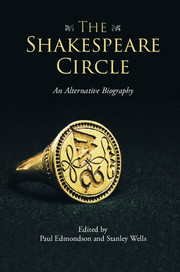Book contents
- Frontmatter
- Contents
- List of illustrations
- List of contributors
- Preface and acknowledgements
- General introduction
- Part I Family
- 1 His Mother Mary Shakespeare
- 2 His father John Shakespeare
- 3 His siblings
- 4 His sister's family: the Harts
- 5 His wife Anne Shakespeare and the Hathaways
- 6 His daughter Susanna Hall
- 7 His son-in-law John Hall
- 8 His son Hamnet Shakespeare
- 9 His daughter Judith and the Quineys
- 10 His granddaughter Lady Elizabeth Barnard
- 11 His ‘cousin’: Thomas Greene
- Part II Friends and Neighbours
- Part III Colleagues and Patrons
- Closing remarks
- Afterword
- Index
- References
5 - His wife Anne Shakespeare and the Hathaways
from Part I - Family
Published online by Cambridge University Press: 05 November 2015
- Frontmatter
- Contents
- List of illustrations
- List of contributors
- Preface and acknowledgements
- General introduction
- Part I Family
- 1 His Mother Mary Shakespeare
- 2 His father John Shakespeare
- 3 His siblings
- 4 His sister's family: the Harts
- 5 His wife Anne Shakespeare and the Hathaways
- 6 His daughter Susanna Hall
- 7 His son-in-law John Hall
- 8 His son Hamnet Shakespeare
- 9 His daughter Judith and the Quineys
- 10 His granddaughter Lady Elizabeth Barnard
- 11 His ‘cousin’: Thomas Greene
- Part II Friends and Neighbours
- Part III Colleagues and Patrons
- Closing remarks
- Afterword
- Index
- References
Summary
Anne Hathaway is arguably the closest member of the Shakespeare circle, but the details about her life have been problematic from her first entry into the history of Shakespeare biography. Though her epitaph was included in William Dugdale's Antiquities of Warwickshire in 1656, Nicholas Rowe's 1709 biography was the first to include her as part of Shakespeare's life story. Rowe writes that Shakespeare's ‘wife was the daughter of one Hathaway, said to have been a substantial yeoman in the neighbourhood of Stratford’ (1709, p. v).
The source of Rowe's information was the retired actor Thomas Betterton, who apparently travelled to Holy Trinity Church in Stratford and looked at the parish records. However, there is no surviving parish record of Anne Hathaway's parentage, birth or marriage. In fact, the only parish record is of her burial; according to her gravestone, she was born before records began in Stratford. Betterton's information must have come from oral tradition rather than parish records, thus the ‘said to have been’ phrase, unless he was privy to parish documents that no longer survive. Later research has confirmed Rowe's account of Anne Hathaway, despite the ambiguity of Betterton's sources. If Betterton did visit Holy Trinity Church in Stratford, he would probably have stood on Anne's grave in order to see the Shakespeare monument (which Rowe mentions). Nevertheless, he omits Anne's birth or death dates in favour of verbal lore. This would not be the last time information about her came to be muddled.
This chapter revisits the various factual details associated with Anne Hathaway and her family, in order to give a clearer picture of realistic possibilities for her life story and for her role in the innermost ring of the Shakespeare circle. The uncertain nature of many of these facts has led to assumptions about Shakespeare's wife that fit with the desires of readers, audiences and tourists for particular ‘Shakespeares’ that build on a particular construction of his wife, but that may obscure other equally plausible narratives. Thus, rather than offer conclusions where there are alternatives, this chapter instead allows various interpretative possibilities to resonate when more than one explanation is possible.
- Type
- Chapter
- Information
- The Shakespeare CircleAn Alternative Biography, pp. 57 - 70Publisher: Cambridge University PressPrint publication year: 2015
References
- 1
- Cited by

